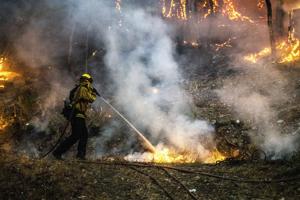After surviving wildfires, Californians bracing for flash flooding

(The Center Square) – After surviving wildfires in the Santa Cruz Mountains, residents are bracing for flashfloods or mudslides.
“Black, charred slopes loom quietly above homes and businesses, poised to become furious rivers of boulders and mud,” The Mercury News reported last month, before Santa Ana winds stirred up more fires this week.
The New York Times reports that precipitation in drought-stricken Central and Northern California could result in flash flooding in areas that burned last year.
In order to be prepared, Santa Cruz County officials released an evacuation map, urging residents to learn their evacuation zones and risk levels, and to prepare to leave in a hurry with a personal evacuation plan already in place. Residents are also encouraged to register for the county’s alert system, CodeRed, if they have not done so already.
Historically, flash floods and mudslides, or mudflows, are more likely to take place after wildfires destroy vegetation and damage the soil so much so that rainfall erodes the slopes.
“A debris flow is a lot like wet cement,” Noah Finnegan, a professor of geomorphology at UC Santa Cruz, told the Mercury News. “It’s capable of moving very large boulders, and it moves a lot faster than water.”
Scientists from the California Geological Survey, Santa Cruz County geologists, and others have surveyed burn areas, looking for geologic evidence of “soil burn severity” to determine where mudslides might occur. The more damaged the soil is from wildfires, the more likely it could erosion and flash flooding or mudslides could occur.
The county published a debris flow hazard area map to help residents prepare for evacuation, emphasizing that there is no way to prevent debris flow or mudslides from happening. The best thing to do is to be prepared to leave before they begin, officials argue.
Santa Cruz County, the National Weather Service, the U.S. Geological Survey and the California Department of Water Resources are working in concert to research, study and address the problem of debris flow and flash floods in previously scorched areas.
Officials suggest that evacuation warnings be made for the following rainfall levels: three-tenths of an inch of rain in 15 minutes, a half inch of rainfall in 30 minutes, or seven-tenths of an inch of rainfall in one hour.
Disclaimer: This content is distributed by The Center Square

